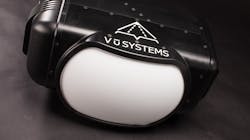Saab chooses VuCube from Vu Systems for enhanced flight vision avionics aboard business aviation aircraft
ORLANDO, Fla. – Avionics designers at aircraft designer Saab AB in Stockholm needed enhanced vision technology to enable airplane pilots to land safely in poor visibility from rain, low clouds, or fog. They found their solution from Vu Systems in Morrisville, N.C.
Vu Systems designed a passive millimeter wave sensor called the Vu Cube, and announced it in October at the 2019 National Business Aviation Association (NBAA) convention in Orlando, Fla.
Saab officials announced at NBAA that their company will manufacture Vu Cubes for Saab's Next Generation Enhanced Flight Vision System, which uses passive millimeter wave imaging technology.
The Vu Cube system can blend these sensors with a terrain database into a synthetic vision system that adds some level of man-made objects. The integrated image shows up on the pilot’s head-up display.
Saab has tested the system on a seven-passenger Beechcraft King Air 200 twin-engine aircraft during more than 100 instrument approaches, company officials say.
The Vu Cube avionics system can image airfields through rain, clouds, and fog at ranges of several miles to help pilots line-up their runway approaches in poor visibility.
Millimeter wave scanning is the basis of full-body imaging devices deployed at airport security checkpoints. The wavelengths of millimeter waves are large enough to pass through most materials, like clothing.
The full-body scanner projects millimeter waves onto the subject and the waves are reflected either by the subject’s skin, or by any objects being carried by the person, so the sensor can detect objects under the subject’s clothes.
The Vu Cube operates by passive millimeter wave scanning, reading thermal energy in the millimeter wave spectrum. The millimeter wave emissions reflected off a ground object like an airport runway are different from emissions reflecting off particles in the air.
Fog and cloud particles are between 10 and 100 microns in size. The Vu Cube reads thermal energy in 3000-micron wavelengths that cut through fog and cloud particles, thus allowing the sensor to detect runways and other objects even through rain and fog.
“The resolution of the Vu Cube camera design is such that it resolves runways, taxiways, roads, and other features,” says Stedman Stevens, CEO of Vu Systems. “For example, you can easily see people and vehicles when close by, and at distances on approach see the runway and taxiways and in some cases the mechanical structures that hold the approach lighting systems in front of the runway.”
The Vu Cube weighs less than 30 pounds, measures 17.75 by 9.5 by 10 inches, and mounts in the aircraft’s nose for a clear forward view. Vu Systems has been developing the technology since 2013.
For more information contact Vu Systems online at www.vusystems.com, or Saab AB at https://saab.com.
Dennis Scimeca is associate editor of Vision Systems Design.
